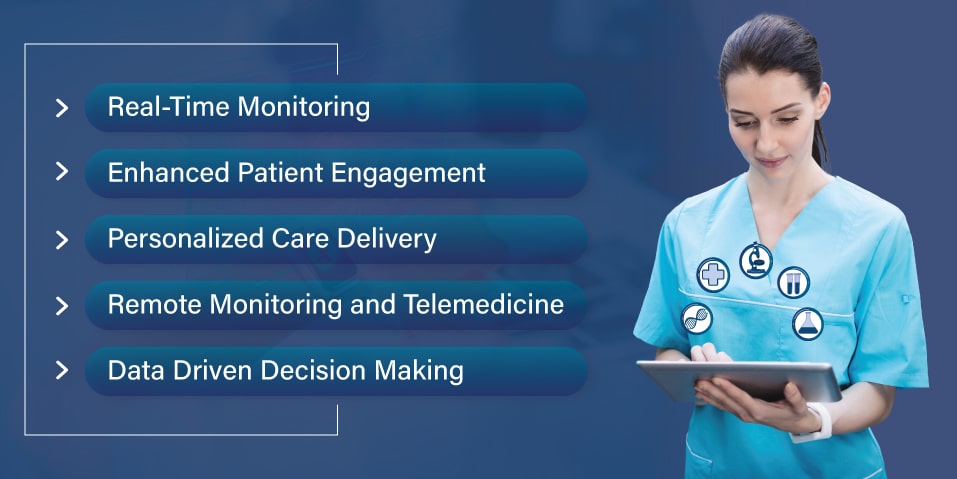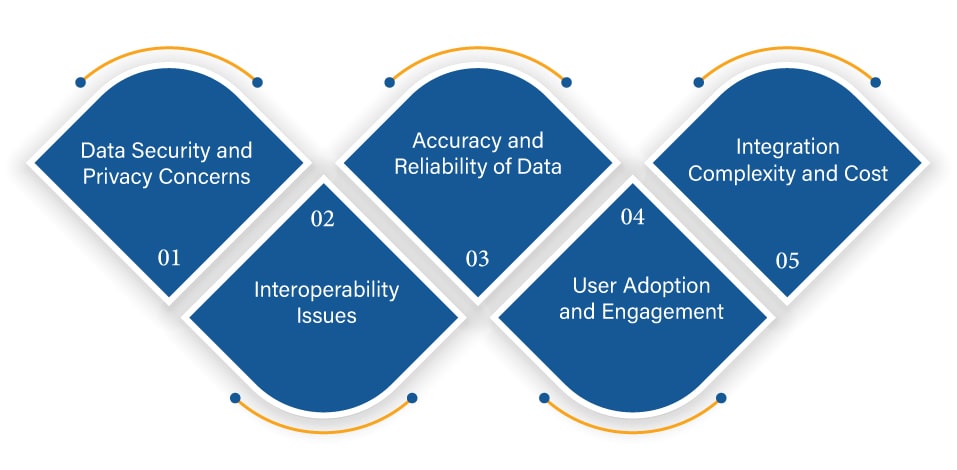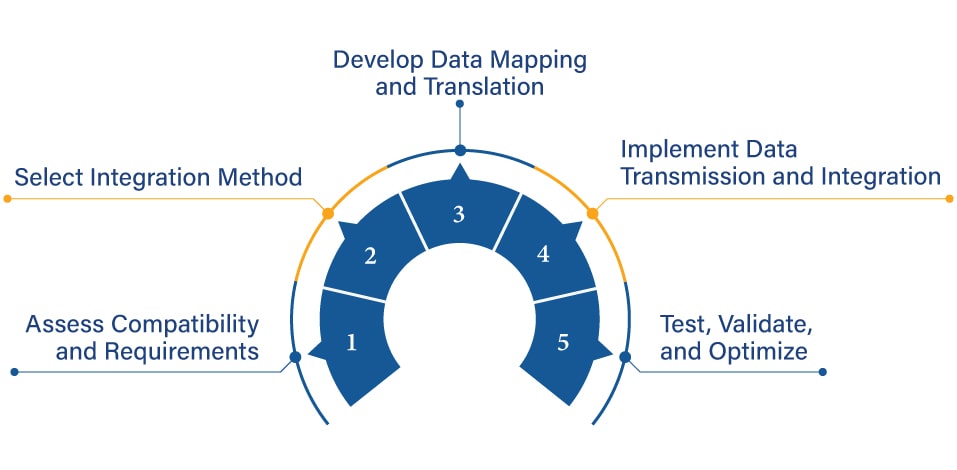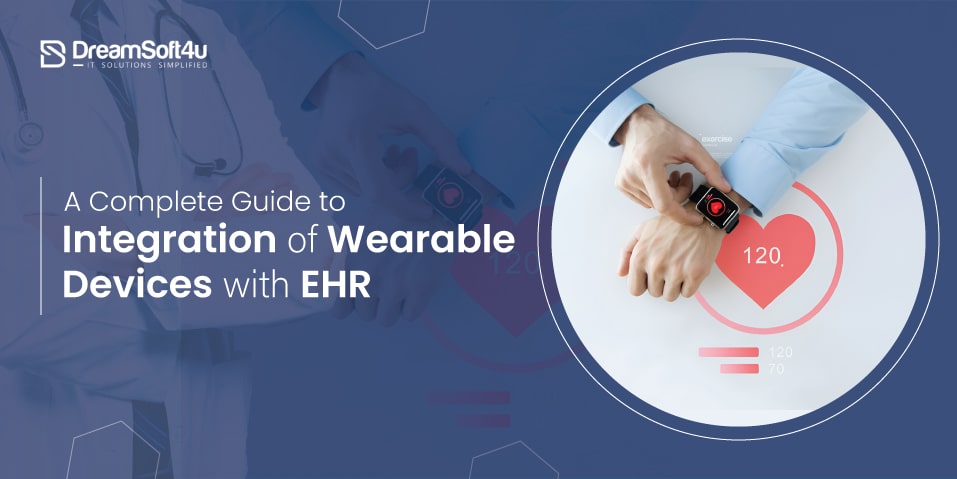Since the last decade, the popularity of wearable devices, especially in the healthcare sector, has increased drastically. The worldwide market of wearable devices for the medical industry is expected to reach nearly 440 million in 2024. From smartwatches to fitness bands and medical-grade sensors, wearable integration devices provide unprecedented opportunities to collect real-time health information in old-school healthcare settings.
Since the healthcare landscape is evolving, the integration between wearable devices and electronic health records or EHR has captured the limelight. It emerges as a pivotal strategy to harness the potential of this technology and enhance patient care. All these devices come with in-built data collection capabilities and sensors, offering patients insights into their sleeping patterns and activity levels.
This comprehensive guide explores everything about wearable integration with EHR. In this guide, we will discuss its benefits, challenges, best practices, and more. So, here we go!
Table of Contents
ToggleIntroduction to Wearable Devices
Wearable devices or wearables are electronic devices worn on different body parts. The primary aim of these devices is to track information in real time. These are equipped with sensors and combine software and hardware technology to monitor patient’s health. These devices rely on biosensors to collect all data from the patient, such as
- Blood pressure
- Heart rate
- Activities
- Sleeping patterns
These are tiny gadgets built using advanced sensors to monitor wellness and fitness accurately. These devices also help in determining the heart rate and disease management. Most people wear them as an added accessory.
Introduction to Electronic Health Records
Electronic Health Records, commonly known as EHR systems, are the storage of protected health information and digital recordings. Within these systems, you can store medical histories of patients, appointment schedules, tailored treatment plans and other vital data related to healthcare.
Best Health Monitoring Wearable Health Technology Devices
1. Smart Health Watches
Smartwatches are the most popular devices which gained attention in the electronic device market. These watches are designed and developed to offer valuable data about your health. Along with managing calls and messages, you can easily get an insight into everyday physical activities, stress levels, or heart problems.
2. Wearable Fitness Trackers
It is another best-used device used for calculating a patient’s heart rate and pulse. These devices also inform you about your physical activities, steps taken, and different sleeping stages.
3. Glucose Meters
Modern blood glucose reading technology is the best available for diabetes glucose monitoring, as is widely known about virtual doctor software. It provides an upper arm-worn device that uses a phone sensor to measure the reading from the device. This device is ideal since it lessens the need for patients to “prick” their fingertips and can be worn for up to seven days at a time.
4. Wearable Blood Pressure Monitor
As per reports, More than 1.28 billion adults suffer from hypertension worldwide. Through the wearable blood pressure monitor device, it becomes easier to keep an eye on the blood pressure. This promotes health and wellness as you are always on your toes to manage your blood pressure. Additionally, it eliminates the need to check blood pressure through cuffs, ultimately enhancing user experience.
Application Areas of EHR Integration with Wearable Devices
Major application areas of the EHR integration with different devices are:
1. Real-time Patient Monitoring
Wearable medical devices, when integrated with the EHR systems, allow healthcare experts and nurses to monitor the patient’s current medical situation and well-being. They rely on real-time and actionable data to come to any outcome.
2. Remote Patient Monitoring
These devices with EHR systems promote remote monitoring capabilities. It allows healthcare experts to closely analyze the patient off-site, which holds great significance, especially in remote settings.
3. Radiology and Medical Diagnostics
A quick integration between EHR systems and devices allows healthcare experts and doctors to access the images, diagnostics, and test results error-free. This simplifies the entire diagnostic process.
4. Medical Analytics and Reporting
Another major application area of wearable device integration and EHR systems is medical analytics and reporting. This integration promotes detailed data analysis, resulting in quality healthcare services and enhanced efficiency.
Benefits of Integration of Wearable Devices with EHR
The major benefits of wearable integration with EHR systems are:

1. Real-Time Monitoring
Healthcare experts can easily access real-time data about patients through the integration between devices and EHR systems. It allows them to continuously monitor all vital signs, activity levels, heart rate, and other health metrics. This timely data promises early detection of any underlying health concern, ensuring health experts can design tailored solutions.
2. Enhanced Patient Engagement
Wearable devices, when integrated with EHR, empower patients to kickstart and participate in their healthcare journey. Since patients have easy access to their health data, it promotes motivation and greater engagement, resulting in enhanced performance and following the treatment plans. It also results in lifestyle modifications that work well for your body.
3. Personalized Care Delivery
Healthcare professionals can customize treatment plans and actions based on the health trends and patterns of individual patients by integrating wearable data with EHR. This individualized approach to treatment lowers healthcare costs, increases patient happiness, and improves the efficacy of interventions.
4. Remote Monitoring and Telemedicine
This integration also facilitates mHealth app initiatives and remote monitoring. Doctors can remotely track the patient’s progress and monitor their health status. They may also conduct in-depth virtual consultations, minimizing the requirements for personal visits. This improves access to care, especially for people living in underserved and rural areas.
5. Data-Driven Decision Making
These devices with EHR systems give easy access to comprehensive data about the patient, allowing doctors to make data-driven and informed decisions. Based on patterns and trends of the patient, they suggest modifications in the treatment which promotes quality care and better experience.
Challenges Faced in Integration of Wearable Devices with EHR

1. Data Security and Privacy Concerns
Wearable device integration in healthcare increases security concerns. Thus, you must choose a reliable development company which follows all security rules to safeguard sensitive patient healthcare data from breaches or unauthorized access.
2. Interoperability Issues
Interoperability issues arise from differences in data formats, standards, and protocols between various technology and EHR systems. Respecting defined data formats and interoperability standards like HL7 FHIR is necessary to achieve seamless data integration and interchange.
3. Accuracy and Reliability of Data
At times, these devices do not reflect accurate results; therefore, the reliability of the data becomes a big question. Some major factors that the data quality are Variability in sensor accuracy, calibration issues, and environmental factors. Therefore, quality assurance processes are conducted.
4. User Adoption and Engagement
At times, patients forget to wear these devices and share data. Therefore, encouraging patients to use these devices and sharing information with the doctors regularly is a major challenge. Major factors like technological literacy, usability issues, and concerns regarding data privacy and security impact user adoption and engagement.
5. Integration Complexity and Cost
This device and EHR system integration entails difficult technical integration tasks and could call for large expenditures on infrastructure, software development, and training. Healthcare institutions need to carefully consider the expenses and resource needs related to integration efforts.
Steps to Integrate Wearable Devices with EHR
Here is the step-by-step process to successfully integrate wearable devices with the EHR:

1. Assess Compatibility and Requirements
First and foremost, you must start by closely analyzing the devices’ compatibility with the existing EHR systems. Understand different kinds of data that need to be captured from wearable devices. Further, determine different integration needs like standards, protocols and data formats.
2. Select Integration Method
Based on the available technical abilities and the company’s needs, choose the best integration method. Common options include:
- Direct APIs or Application Programming Interfaces
- Middleware platforms
- Third-party integration solutions
Consider factors including data security, scalability, and ease of implementation when choosing the integration method.
3. Develop Data Mapping and Translation
Create procedures for data translation and mapping to guarantee smooth data transfer between wearable technology and EHR systems. Define mappings, taking into consideration data formats, units of measurement, and data normalization needs, between data components captured by wearables and relevant fields in the EHR.
4. Implement Data Transmission and Integration
To make it easier for data to go from wearables to EHR systems, implement data transmission and integration protocols. To provide bi-directional data transmission while maintaining data security, integrity, and regulatory compliance, configure APIs, create bespoke interfaces, or implement middleware solutions.
5. Test, Validate, and Optimize
To make sure that the data is accurately transmitted, captured, and displayed, you must conduct detailed integration testing and validation. Test various scenarios like:
- different types of devices
- data synchronization
- error handling
Carefully optimize and monitor the integration of devices with EHR to answer all problems and bottlenecks. This promises a smooth operation over time.
Are You Planning to Build a Wearable App for Healthcare?
We’ve a team of experts to turn your vision into reality
Future of Integration of Wearable Devices with EHR
The popularity of the integration of devices with EHR is increasing rapidly. Thus, it is believed that the future of integrating wearable devices with EHR systems potentially results in first-aid drones, virtual care and enhanced patient experiences.
In the future, wearable devices might be used in clinical trials for collecting real-time information, which promotes patient engagement. Although there are certain potential challenges around this integration, these device development companies suggest effective solutions to overcome these problems. In all, it can be said that ‘the future of integration of wearable devices with EHR is quite bright’!
How Can DreamSoft4U Help You?
DreamSoft4U is a software development company based in the USA. We have over two decades of relevant experience. Our team is involved in building great quality software to cater to your needs. We have a team of more than a hundred skilled professionals offering telemedicine solutions. As an experienced mobile app development team, we believe in offering patient-centric solutions to make informed decisions. If you are on the hunt for the best development company, get in touch with experts at DreamSoft4U now!
Wrapping Up
The wearable devices integration with electronic health records is a key development in today’s healthcare. It allows healthcare experts to offer personalized and comprehensive care backed by real-time data. As per a report, over 325 million people use medical wearables worldwide as these devices provide unmatched benefits to patients.
Besides all the advantages, there are certain challenges that you may come across during the Wearable App Development. If you plan to integrate these medical devices with EHR, rely on a skilled development company. For the best solutions, meet experts at DreamSoft4U.
FAQs
1. What are the major challenges faced while integrating wearable data with EHRs?
Wearable data integration with EHRs opens doors for several challenges, including maintaining privacy and security, ensuring data compatibility, and overcoming all technical hurdles regarding data formats.
2. Why is it important to integrate wearable data with the EHR?
The integration between all devices and EHR is a major advancement in the healthcare industry. It includes offering insight into patients’ real-time data. This allows healthcare experts to suggest tailored solutions, improving decision-making and overall patient care.
3. What are some popular health monitoring devices used every day?
Blood pressure monitors and glucose meters are popular health monitoring devices. These can be used on an everyday basis to keep track of your health.
4. Mention future possibilities for the integration of wearable devices with EHR
The future of these devices and EHR is highly promising. Thus, it holds great future possibilities, including:
- Personalized diagnosis and treatment
- Enhanced workflows and reduced ambiguity
- Enhanced productivity and better decision support.
5. What wearable devices monitor?
These devices are used for monitoring things such as fitness data, pulse and sleep. For example, organic polymers easily transform signals into electronic signals from the biological tissue used in transistors.























